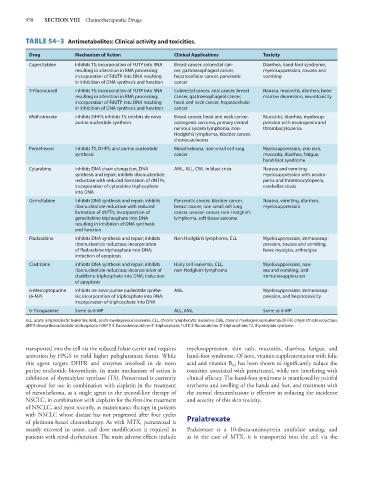Page 972 - Basic _ Clinical Pharmacology ( PDFDrive )
P. 972
958 SECTION VIII Chemotherapeutic Drugs
TABLE 54–3 Antimetabolites: Clinical activity and toxicities.
Drug Mechanism of Action Clinical Applications Toxicity
Capecitabine Inhibits TS; incorporation of FUTP into RNA Breast cancer, colorectal can- Diarrhea, hand-foot syndrome,
resulting in alteration in RNA processing; cer, gastroesophageal cancer, myelosuppression, nausea and
incorporation of FdUTP into DNA resulting hepatocellular cancer, pancreatic vomiting
in inhibition of DNA synthesis and function cancer
5-Fluorouracil Inhibits TS; incorporation of FUTP into RNA Colorectal cancer, anal cancer, breast Nausea, mucositis, diarrhea, bone
resulting in alteration in RNA processing; cancer, gastroesophageal cancer, marrow depression, neurotoxicity
incorporation of FdUTP into DNA resulting head and neck cancer, hepatocellular
in inhibition of DNA synthesis and function cancer
Methotrexate Inhibits DHFR; inhibits TS; inhibits de novo Breast cancer, head and neck cancer, Mucositis, diarrhea, myelosup-
purine nucleotide synthesis osteogenic sarcoma, primary central pression with neutropenia and
nervous system lymphoma, non- thrombocytopenia
Hodgkin’s lymphoma, bladder cancer,
choriocarcinoma
Pemetrexed Inhibits TS, DHFR, and purine nucleotide Mesothelioma, non-small cell lung Myelosuppression, skin rash,
synthesis cancer mucositis, diarrhea, fatigue,
hand-foot syndrome
Cytarabine Inhibits DNA chain elongation, DNA AML, ALL, CML in blast crisis Nausea and vomiting,
synthesis and repair; inhibits ribonucleotide myelosuppression with neutro-
reductase with reduced formation of dNTPs; penia and thrombocytopenia,
incorporation of cytarabine triphosphate cerebellar ataxia
into DNA
Gemcitabine Inhibits DNA synthesis and repair; inhibits Pancreatic cancer, bladder cancer, Nausea, vomiting, diarrhea,
ribonucleotide reductase with reduced breast cancer, non-small cell lung myelosuppression
formation of dNTPs; incorporation of cancer, ovarian cancer, non-Hodgkin’s
gemcitabine triphosphate into DNA lymphoma, soft tissue sarcoma
resulting in inhibition of DNA synthesis
and function
Fludarabine Inhibits DNA synthesis and repair; inhibits Non-Hodgkin’s lymphoma, CLL Myelosuppression, immunosup-
ribonucleotide reductase; incorporation pression, nausea and vomiting,
of fludarabine triphosphate into DNA; fever, myalgias, arthralgias
induction of apoptosis
Cladribine Inhibits DNA synthesis and repair; inhibits Hairy cell leukemia, CLL, Myelosuppression, nau-
ribonucleotide reductase; incorporation of non-Hodgkin’s lymphoma sea and vomiting, and
cladribine triphosphate into DNA; induction immunosuppression
of apoptosis
6-Mercaptopurine Inhibits de novo purine nucleotide synthe- AML Myelosuppression, immunosup-
(6-MP) sis; incorporation of triphosphate into RNA; pression, and hepatotoxicity
incorporation of triphosphate into DNA
6-Thioguanine Same as 6-MP ALL, AML Same as 6-MP
ALL, acute lymphoblastic leukemia; AML, acute myelogenous leukemia; CLL, chronic lymphocytic leukemia; CML, chronic myelogenous leukemia; DHFR, dihydrofolate reductase;
dNTP, deoxyribonucleotide triphosphate; FdUTP, 5-fluorodeoxyuridine-5′-triphosphate; FUTP, 5-fluorouridine-5′-triphosphate; TS, thymidylate synthase.
transported into the cell via the reduced folate carrier and requires myelosuppression, skin rash, mucositis, diarrhea, fatigue, and
activation by FPGS to yield higher polyglutamate forms. While hand-foot syndrome. Of note, vitamin supplementation with folic
this agent targets DHFR and enzymes involved in de novo acid and vitamin B has been shown to significantly reduce the
12
purine nucleotide biosynthesis, its main mechanism of action is toxicities associated with pemetrexed, while not interfering with
inhibition of thymidylate synthase (TS). Pemetrexed is currently clinical efficacy. The hand-foot syndrome is manifested by painful
approved for use in combination with cisplatin in the treatment erythema and swelling of the hands and feet, and treatment with
of mesothelioma, as a single agent in the second-line therapy of the steroid dexamethasone is effective in reducing the incidence
NSCLC, in combination with cisplatin for the first-line treatment and severity of this skin toxicity.
of NSCLC, and most recently, as maintenance therapy in patients
with NSCLC whose disease has not progressed after four cycles
of platinum-based chemotherapy. As with MTX, pemetrexed is Pralatrexate
mainly excreted in urine, and dose modification is required in Pralatrexate is a 10-deaza-aminopterin antifolate analog, and
patients with renal dysfunction. The main adverse effects include as in the case of MTX, it is transported into the cell via the

